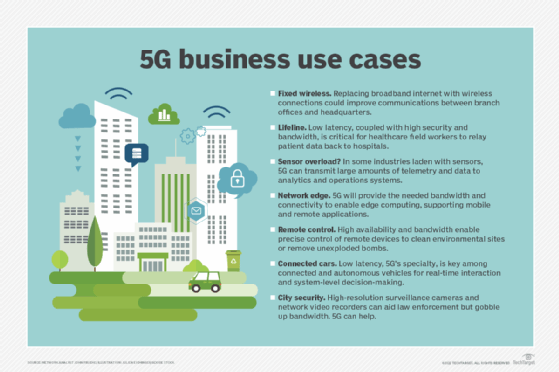What are eMBB, URLLC and mMTC in 5G? Use cases explained
eMBB, URLLC and mMTC are three important primary service categories related to 5G technology. Each concept represents a use case that 5G networks must meet to reach high data rates and low latency.
- eMBB, or Enhanced Mobile Broadband, is a 5G category for high data rates and bandwidth.
- URLLC, or Ultra-Reliable Low Latency Communications, is a 5G category for low latency and high reliability.
- mMTC, or Massive Machine-Type Communications, is a 5G category for supporting large numbers of devices.
While the most mentioned aspect of 5G is its speed, 5G networks have more potential use cases other than high-speed broadband services. eMBB, URLLC and mMTC all help to define the categorical use cases of 5G.
How does 5G use eMBB?
eMBB focuses on fast data speeds and higher capacity for mobile broadband applications. Peak eMBB data rates range from 10-20 gigabits per second (Gbps), but could be slower in practice due to variables such as environmental conditions.
When there are many users on a network, capacity needs must also be higher to ensure consistent data rates. eMBB also needs to prioritize high mobility to maintain a consistent data rate. If users are moving around geographically, such as in a car or on a train, their data rate should remain steady.
eMBB is suitable for high-definition video streaming, downloading content to a mobile device and virtual reality.
How does 5G use URLLC?
URLLC focuses on providing extremely low latency and high reliability. URLLC offers end-to-end latency of 1 millisecond (ms) between user devices and 5G base stations, with up to 99.9999% availability. In practice, latency can be closer to 5 ms. Compared to eMBB, its data rates are slower, ranging from 50 kilobits per second (kbps) to 10 megabits per second (Mbps).
URLLC uses a combination of technologies, including 5G New Radio (NR), network slicing, edge computing and frequency management to minimize latency and maximize reliability.
URLLC is suitable for any use case that requires low latency and high availability, such as in autonomous vehicles, healthcare and industrial applications.
How does 5G use mMTC?
mMTC focuses on connecting large numbers of devices in an area simultaneously. MTC can connect up to 1 million low-power and low-data-rate devices per square kilometer. mMTC supports lower data rates, ranging from 1 kbps to 100 kbps, with higher latency levels compared to eMBB and URLLC.
5G mMTC emphasizes efficiency, wide coverage and lightweight communication protocols that prioritize small packet data transmissions.
mMTC is ideal for applications such as IoT networks, smart city sensors, agriculture and environmental monitoring systems.
How can organizations adopt 5G technology?
Knowledge of these three service categories will help guide organizations seeking to implement 5G NR into their business, as each is separable into different use cases. For businesses seeking to increase mobile broadband speeds, eMBB is the right choice. In situations where low latency or reliability is a top priority, URLLC will be the right choice. Likewise, for businesses looking to implement a large-scale IoT environment, mMTC is the right choice.

From here, organizations can begin to assess their infrastructure and network requirements, as well as the deployment of any necessary compatible devices or sensors. 5G infrastructure typically includes three functional areas that include a radio access network, a core network and an edge computing network. Security, scalability, and integration must also be taken into consideration.
Implementing 5G technology within an organization is a significant undertaking. Follow this guide to learn more about planning for and implementing 5G.







